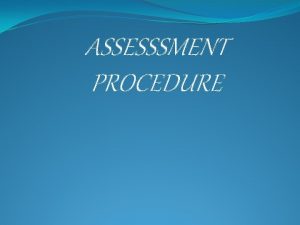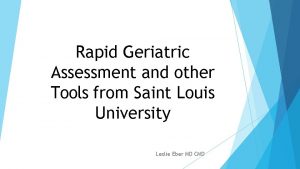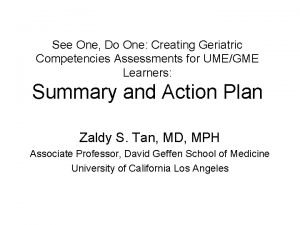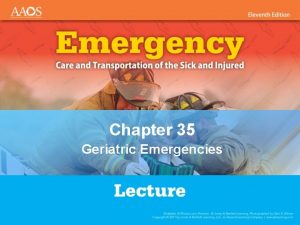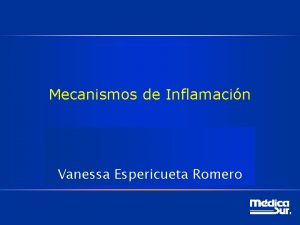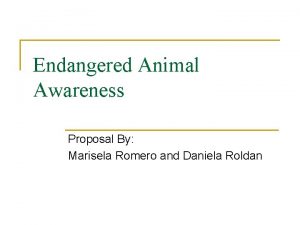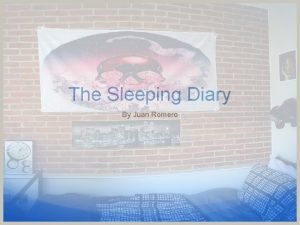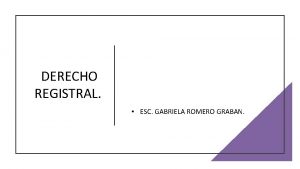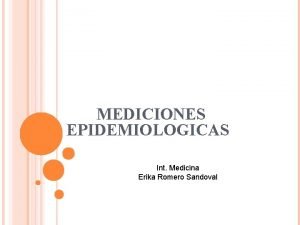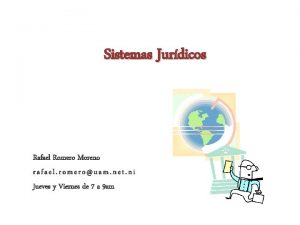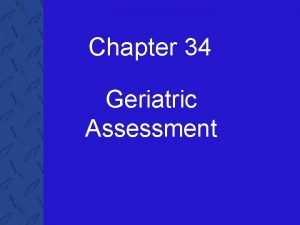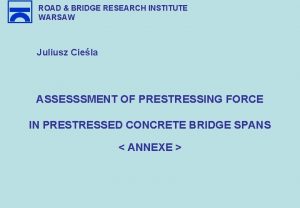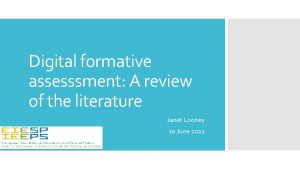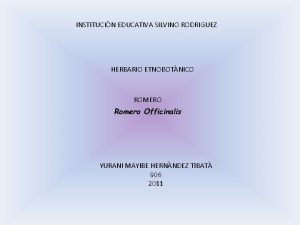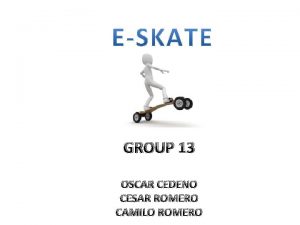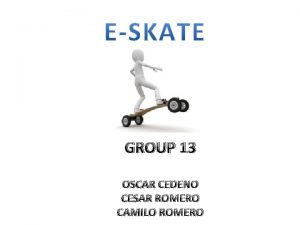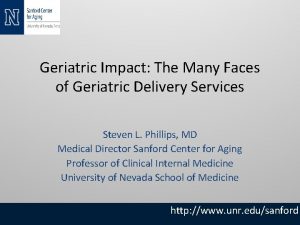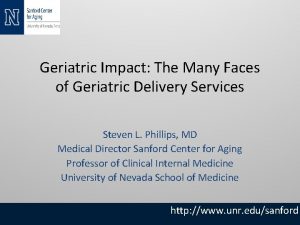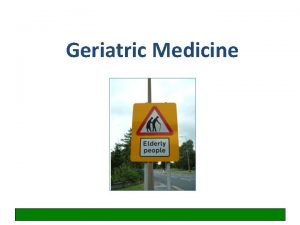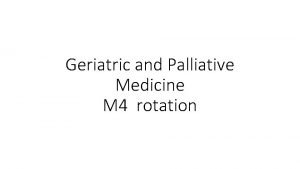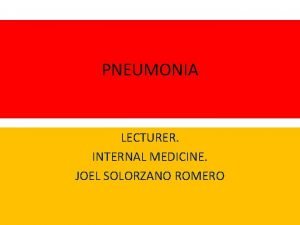GERIATRIC ASSESSMENT LECTURER Dr JOELSOLOZANO ROMERO GERIATRIC ASSESSSMENT

















































- Slides: 49

GERIATRIC ASSESSMENT LECTURER. Dr JOELSOLOZANO ROMERO

GERIATRIC ASSESSSMENT The geriatric assessment is a multidimensional, multidisciplinary diagnostic instrument designed to collect data on the medical, psychosocial and functional capabilities and limitations of elderly patients. Various geriatric practitioners use the information generated to develop treatment and long-term follow-up plans, arrange for primary care and rehabilitative services, organize and facilitate the intricate process of case management, determine long-term care requirements and optimal placement, and make the best use of health care resources

Approximately one-half of the ambulatory 65 than older primary adultsfor care years is provided by family physicians and approximately 22 Percent of visits to family physicians are from older adults. It is estimated that older adults will comprise at least 30 percent of the patients in typical family medicine outpatient practices , 60 home care practices.

CHARACTERISTICS The geriatric assessment differs from a standard medical evaluation in three general ways: (1) it focuses on elderly individuals with complex problems (2) it emphasizes functional status and quality of life (3) it frequently takes advantage of an interdisciplinary team of providers.

Performing a comprehensive assessment is an ambitious undertaking. • Current symptoms and illnesses and their functional impact. • Current medications, their indications and effects. • Relevant past illnesses. • Recent and impending life changes. • Objective measure of overall personal and social functionality. • Current and future living environment and its appropriateness to function and prognosis. • Family situation and availability. • Current caregiver network including its deficiencies and potential. • Objective measure of cognitive status. • Objective assessment of mobility and balance. • Rehabilitative status and prognosis if ill or disabled. • Current emotional health and substance abuse. • Nutritional status and needs. • Disease risk factors, screening status, and health promotion activities. • Services required and received.

COMMUNICATION STRATEGIES ESTABLISH A FRIENDLY RELATIONSHIP • Introduce yourself • Address the patient by last name • Face the patient directly • Sit at eye level • • Speak slowly in a deep tone • • Ask open-ended questions: “What would you like me to do for you? ”

• Inquire about hearing deficits, raise voice volume accordingly • If necessary, write questions in large print • Allow ample time for patient to answer

PRINCIPLES OF GERIATRIC ASSESSMENT Goal. Promote wellness, independence Focus. Function performance (gait, balance, transfers) Scope. Physical, cognitive, psychologic, social domains Approach. Multidisciplinary Efficiency. Ability to perform rapid screens to identify target areas Success. Maintaining or improving quality of life

Comprehensive Geriatric Assessment • An interdisciplinary approach to the evaluation of older persons’ physical and psychosocial impairments and their functional disabilities • 3 -step process: 1. Targeting appropriate patients 2. Assessing patients and developing recommendations 3. Implementing recommendations

Purpose • Highest priority: – Prevention of decline in the independent performance of ADLs – Drives the diagnostic process and clinical decision making • Screen for preventable diseases • Screen for functional impairments that may result in physical disability and amenable to intervention

Rationale • Early detection of risk factors for functional decline when linked to specific interventions may help reduce the incidence of functional disability and dependency for older patients

The Comprehensive Assessment of an Older Person • • Domains of Assessment Sources of collateral information Use of professional interview style Timeliness and consistency Interdisciplinary Use of Validated assessment tools Questions

Patient Focused Assessment: • • Privacy and confidentiality; Information Consent A carer/advocate Participate in decision-making A copy of the assessment/outcomes Complaint and appeal information. Explain reason for assessment

The Comprehensive Assessment of an Older Person Domains of Assessment • • • Physical Mental Social Environmental Functional - physical mental social activities of daily life

The Comprehensive Assessment of an Older Person Benefits of Comprehensive Geriatric Assessment Depends upon setting but, overall: • • • Improved diagnostic attainment Increased use of home health services Reduced medical care costs Reduced length of hospital stay Reduced or delayed admission to institutional care Improved functional status : fewer medications : improved cognition • Reduced readmission rates • Increased survival (less often)

The Comprehensive Assessment of an Older Person Aims and Framework of Assessment • Improve, maintain or reduce rate of functional decline. • Aim to improve or maintain independence and autonomy. • Multidisciplinary assessment to harness specialty skills in key areas. • Translation of assessment to action plans to add value to care, is critical.

Sources of Collateral Information: • Introduction to patient • Consent for interview, focus on the patient initially • Not performance theatre, recognise privacy • Extended to involve most important others as appropriate • Avoid pre-interview sessions where possible

Timeliness and Consistency: • The hallmark of the Geriatric syndrome is where an older person is predisposed to an adverse event that only requires a precipitant to occur e. g. Falls and injury New incontinence Delirium Reduced mobility Iatrogenic events

The Comprehensive Assessment of an Older Person What are the clues for increasing urgency? • Age – extreme • Lives alone • Source of referral • Urgency annotation • New features of illness • Polypharmacy • Recent functional decline • Worsening confusion (i. e. delirium)

The Comprehensive Assessment of an Older Person Medically-orientated Assessment • The Geriatric Assessment is performed in addition to standard medical history and physical examination. • The assessment seeks to uncover common conditions of frailty that affect functional status, e. g. - Impaired vision - Impaired hearing - Reduced mobility and falls - Geriatric syndromes - Cognition Depression Malnutrition Urinary incontinence Falls Iatrogenic illness

The Comprehensive Assessment of an Older Person INTERDISCIPLINARY • The comprehensive assessment can be done by a generic elderly health care worker, a General Practitioner, medical specialist or through a multi-disciplinary approach. • It can be extended over time and place. • The tools of assessment are the structured interview utilising screening instruments for: Cognitive Affective Functional Social (context and consequences) Economic status • Assessment especially useful for : » People in transition » Recent onset of physical or cognitive impairment

Comprehensive Geriatric Assessment Who needs a geriatric assessment?

Comprehensive Geriatric Assessment • Too Sick to Benefit – Critically ill or medically unstable – Terminally ill – Disorders with no effective treatment • Appropriate and Will Benefit – Multiple interacting biopsychological problems that are amenable to treatment – Disorders that require rehabilitation therapy

Comprehensive Geriatric Assessment • Too Well to Benefit – One or a few medical conditions – Needing prevention measures only

Who Needs Assessments? • • • For patients with living situation in transition Recent development of physical or cognitive impairments Patients with fragmented specialty medical care Evaluating patient competency/capacity Dealing with medico-legal issues NIH Consensus Devt Conf JAGS, 1990

Physical Health • The geriatric assessment incorporates all facets of a conventional medical history, including main problem, current illness, past and current medical problems, family and social history, demographic data, and a review of systems. The approach to the history and physical examination, however, should be specific to older persons. In particular, topics such as nutrition, vision, hearing, fecal and urinary continence, balance and fall prevention, osteoporosis, and polypharmacy shoul be included in the evaluation


Functional Assessment Functioning can be assessed through informal means, such as observing the individual, and asking the individual, family, and staff questions, or through formal testing. Historically, functioning as been formally assessed through ADL and IADL rating scales.

Comprehensive Geriatric Assessment KATZ INDEX OF ACTIVITIES OF DAILY LIVING • Bathing • Dressing • Toileting • Transfer • Continence • Feeding Independent Assistance Dependent Katz S et al. Studies of Illness in the Aged: The Index of ADL; 1963.


Comprehensive Geriatric Assessment INSTRUMENTAL ACTIVITIES OF DAILY LIVING • Telephone • Traveling • Shopping • Preparing meals • Housework • Medication • Money Independent Assistance Dependent The Oars Methodology: Multidimensional Functional Assessment Questionnaire; 1978.

Financial capacity is a complex, multidimensional construct representing a broad range of conceptual, pragmatic, and judgmental skills Specific Abilities and Tasks The first functional element is specific financial abilities or tasks, each of which is relevant to a particular domain of financial activity. In the model, many general domains can be further broken down into component tasks or abilities that emphasize understanding and pragmatic application of skills relevant to a specific domain. For instance, the domain of financial conceptual knowledge involves understanding concepts, such as loans and savings, and also using this information to select advantageous interest rates. Similarly, bill payment involves not only understanding what a bill is and why it should be paid, but accurately reviewing a bill and preparing it for mailing.

Assessing Cognition During the Clinical Interview Although cognitive testing will provide the standardized data to determine the presence or absence of impaired cognition, interview data can also provide a wealth of information regarding the nature and extent of the impairment. Many clinicians will begin with a brief mental status screening using an interview format or specific screening test to obtain an estimate of level of functioning

Cognitive screening tests are useful for giving a general level of overall cognitive impairment. They may be used as an overall screening to determine whether additional testing is needed. They may also be used for individuals with more severe levels of impairment who cannot complete other tests

MMSE Mini Mental State Examination 30 -point screening instrument that assesses orientation, immediate registration of three words, attention and calculation, short-term recall of three words, language, and visual construction

Comprehensive Geriatric Assessment THE FOLSTEIN MINI-MENTAL STATE EXAMINATION Orientation: What is the year/season/date/day/month? Orientation: What is the year/season/date/day/month? Where are we state/county/town/hospital/floor? Registration: Name 3 objects: 1 second to say each. Then ask the patient all 3 after you have said them. Attention/ Calculation: Begin with 100 and count backward by 7. Alternatively, spell “WORLD” backwards. Recall: Ask for all 3 objects repeated above.

Comprehensive Geriatric Assessment THE FOLSTEIN MINI-MENTAL STATE EXAMINATION Language: Show a pencil & a watch and ask the patient to Language: Show a pencil & a watch and ask the patient to name them. Repeat: “No ifs, and or buts. ” A 3 stage command: “Take the paper in your right hand fold it in half, and put it on the floor. ” Read and obey the following: CLOSE YOUR EYES. Ask a patient to write a sentence. Copy a design (complex polygon).

Clock Drawing Test • Clock Drawing Test: – “Draw a clock” • Sensitivity=75. 2% • Specificity=94. 2%

The Mini-Cog • Components – 3 item recall: give 3 items, ask to repeat, divert and recall – Clock Drawing Test (CDT) • Normal (0): all numbers present in correct sequence and position and hands readably displayed the represented time • Abnormal Mini-Cog scoring with best performance – Recall =0, or – Recall ≤ 2 AND CDT abnormal Borson S. et al Int J Geriatr Psychiatry 2000; 15: 1021 -1027

Clock Drawing Test Instructions – Subjects told to • Draw a large circle • Fill in the numbers on a clock face • Set the hands at 8: 20 – No time limit given – Scoring (subjective): • • 0 (normal) 1 (mildly abnormal) 2 (moderately abnormal) 3 (severely abnormal) 11 12 1 2 10 9 3 4 8 7 6 5 Borson S. et al Int J Geriatr Psychiatry 2000; 15: 1021 -1027

Animal Naming Test • Category fluency • Highly sensitive to Alzheimer’s disease • Scoring equals number named in 1 minute – Average performance = 18 per minute – < 12 / minute = abnormal • Requires patient to use temporal lobe semantic stores • 60 seconds • Using a cutoff of 15 in one minute: – Sens 87% - 88% – Spec 96% Canninng, SJ Duff, et al. ; Diagnostic utility of abbreviated fluency measures in Alzheimer disease and vascular dementia; Neurology Feb. 2004, 62(4)

Mood and Symptoms of Depression, Anxiety, and Psychoses Definition: These scales assess the individual’s degree of depressed or anxious mood, and associated symptoms, such as insomnia, fatigue, low energy, low appetite, loss of interest or pleasure, irritability, feelings of helplessness, worthlessness, hopelessness, or suicidal ideation. Some scales will also assess the degree of hallucinations, delusions, and suspicious or hostile thought processes.

Depression • 10% of >65 y/o with depressive symptoms • 1% with major depressive disorder • Associated with physical decline of community-dwelling adults and hospitalized patients Foley K Hosp Med, 1996

Comprehensive Geriatric Assessment GERIATRIC DEPRESSION SCALE (Short Form) 1. Are you basically satisfied with your life? 2. Have you dropped any of your activities? 3. Do you feel that your life is empty? 4. Do you often get bored? 5. Are you in good spirits most of the time? 6. Are you afraid that something bad is going to happen to you? 7. Do you feel happy most of the time? 8. Do you often feel helpless? Yesavage JA. Clinical Memory Assessment of Older Adults. 1986.

Comprehensive Geriatric Assessment GERIATRIC DEPRESSION SCALE (Short Form) 9. Do you prefer to stay home at night, rather than go out and do new things? 10. Do you feel that you have more problems with memory than most. 11. Do you think it is wonderful to be alive now? 12. Do you feel pretty worthless the way you are now? 13. Do you feel full of energy? 14. Do you feel that your situation is hopeless? 15. Do you think that most persons are better off than you are? Yesavage JA. Clinical Memory Assessment of Older Adults. 1986.

Comprehensive Geriatric Assessment • Other domains to be assessed: – Current health status: nutritional risk, health behaviors, tobacco, and ETOH use and exercise – Social assessments: especially elder abuse if applicable – Health promotion and disease prevention – Values history: advanced directives, end of life care

Comprehensive Geriatric Assessment • Report Outline – Reason for evaluation – Medical history, current health status – Functional status – Social assessment, current psychiatric status – Preference for care in event of severe illness – Summary statement – Care plan

Comprehensive Geriatric Assessment • Care Plan – Recommended services: either agency or family members – How often will it be provided – How long it will be provided – What financing arrangements will pay for it – DYNAMIC PLAN, CONTINUAL ASSESSMENT

Comprehensive Geriatric Assessment What am I going to do with the information obtained? • The most critical step for clinicians is the integration of the data that have been obtained form the instruments. • A common pitfall is to establish a diagnosis that is based solely on poor performance on an assessment instrument. • Information obtained is sometimes underutilized or ignored by clinicians.
 Lecturer's name
Lecturer's name Assesssment
Assesssment Rapid geriatric assessment
Rapid geriatric assessment Geriatric competency assessment
Geriatric competency assessment Gems diamond geriatric assessment
Gems diamond geriatric assessment Spe distinguished lecturer
Spe distinguished lecturer Cfa lecturer handbook
Cfa lecturer handbook Designation lecturer
Designation lecturer Spe distinguished lecturer
Spe distinguished lecturer Pearson lecturer resources
Pearson lecturer resources Good afternoon teachers
Good afternoon teachers Lecturer asad ali
Lecturer asad ali Designation of lecturer
Designation of lecturer Lector vs lecturer
Lector vs lecturer Photography lecturer
Photography lecturer Why himalayan rivers are pernnial in nature
Why himalayan rivers are pernnial in nature Physician associate lecturer
Physician associate lecturer Lecturer in charge
Lecturer in charge Lecturer in charge
Lecturer in charge Lecturer name
Lecturer name Jesus adrian romero nacionalidad
Jesus adrian romero nacionalidad Romero comercio justo
Romero comercio justo Juana mercedes romero velarde
Juana mercedes romero velarde Alberto romero ania
Alberto romero ania Ies romero vargas
Ies romero vargas Vanessa espericueta
Vanessa espericueta Marisela romero
Marisela romero Marty romero
Marty romero Dr. juan romero
Dr. juan romero Pastor alexis romero
Pastor alexis romero Carlos romero zarco
Carlos romero zarco Ruth romero
Ruth romero Romero comercio justo
Romero comercio justo Flores papilionadas
Flores papilionadas Cas romero
Cas romero Vicente romero redondo
Vicente romero redondo Pascal romero
Pascal romero Ramas del derecho notarial
Ramas del derecho notarial Definicion de epidemiologia
Definicion de epidemiologia Romero twink
Romero twink Pccd egrants
Pccd egrants Petra montoro romero
Petra montoro romero Alberto romero ania
Alberto romero ania Julio romero de torres pinto a la mujer
Julio romero de torres pinto a la mujer Rafael moreno romero
Rafael moreno romero Jaime marroquin
Jaime marroquin Regis romero
Regis romero Dr. juan romero
Dr. juan romero Great coffee de romero britto
Great coffee de romero britto Argon element symbol
Argon element symbol

